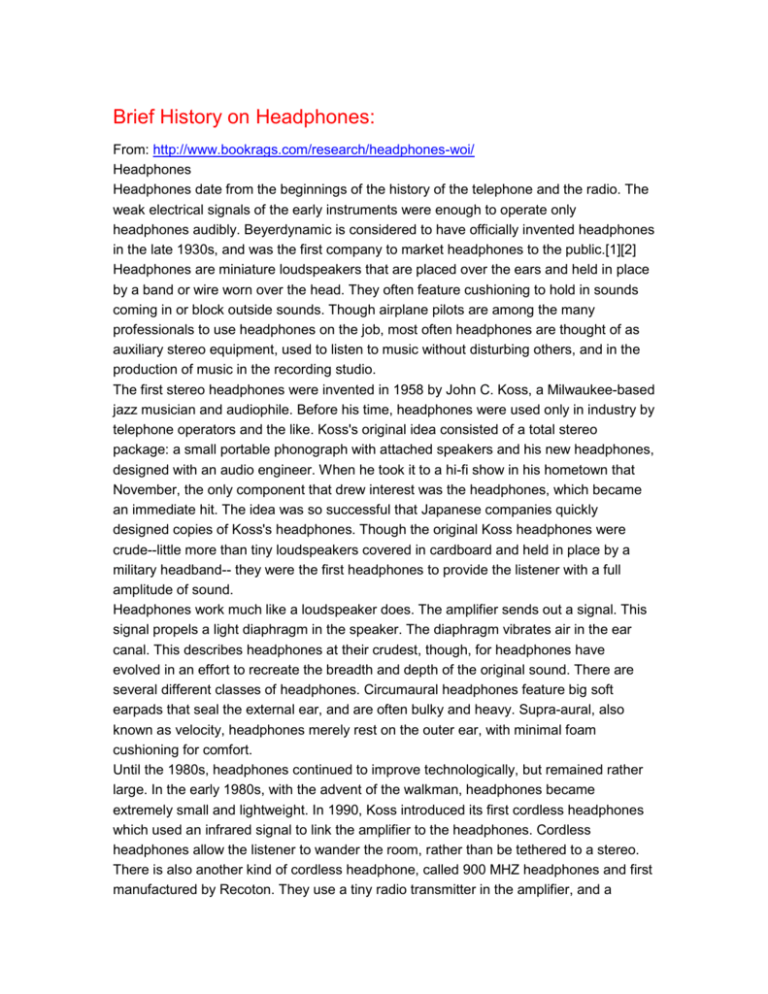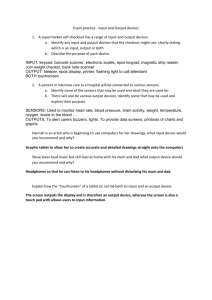
Brief History on Headphones:
From: http://www.bookrags.com/research/headphones-woi/
Headphones
Headphones date from the beginnings of the history of the telephone and the radio. The
weak electrical signals of the early instruments were enough to operate only
headphones audibly. Beyerdynamic is considered to have officially invented headphones
in the late 1930s, and was the first company to market headphones to the public.[1][2]
Headphones are miniature loudspeakers that are placed over the ears and held in place
by a band or wire worn over the head. They often feature cushioning to hold in sounds
coming in or block outside sounds. Though airplane pilots are among the many
professionals to use headphones on the job, most often headphones are thought of as
auxiliary stereo equipment, used to listen to music without disturbing others, and in the
production of music in the recording studio.
The first stereo headphones were invented in 1958 by John C. Koss, a Milwaukee-based
jazz musician and audiophile. Before his time, headphones were used only in industry by
telephone operators and the like. Koss's original idea consisted of a total stereo
package: a small portable phonograph with attached speakers and his new headphones,
designed with an audio engineer. When he took it to a hi-fi show in his hometown that
November, the only component that drew interest was the headphones, which became
an immediate hit. The idea was so successful that Japanese companies quickly
designed copies of Koss's headphones. Though the original Koss headphones were
crude--little more than tiny loudspeakers covered in cardboard and held in place by a
military headband-- they were the first headphones to provide the listener with a full
amplitude of sound.
Headphones work much like a loudspeaker does. The amplifier sends out a signal. This
signal propels a light diaphragm in the speaker. The diaphragm vibrates air in the ear
canal. This describes headphones at their crudest, though, for headphones have
evolved in an effort to recreate the breadth and depth of the original sound. There are
several different classes of headphones. Circumaural headphones feature big soft
earpads that seal the external ear, and are often bulky and heavy. Supra-aural, also
known as velocity, headphones merely rest on the outer ear, with minimal foam
cushioning for comfort.
Until the 1980s, headphones continued to improve technologically, but remained rather
large. In the early 1980s, with the advent of the walkman, headphones became
extremely small and lightweight. In 1990, Koss introduced its first cordless headphones
which used an infrared signal to link the amplifier to the headphones. Cordless
headphones allow the listener to wander the room, rather than be tethered to a stereo.
There is also another kind of cordless headphone, called 900 MHZ headphones and first
manufactured by Recoton. They use a tiny radio transmitter in the amplifier, and a
receiver in the headphones. The 900 MHZ headphones have one significant advantage
over infrared: the listener does not have to be in the same room, within a limited distance
of the stereo, to listen. With 900 MHZ headphones, one can amble up to 150 ft (about
45.5 m) from the signal's source. Despite the advantages, these radio headphones were
banned in Great Britain in 1997 because they work on an already assigned frequency.
In the future, digital radio technology will probably supplant both of these types of
cordless headphones. Other burgeoning headphone technologies that will make
headway include 3-D headphones (also known as surround sound headphones) which
feature two or three small speakers on each side, creating the effect of space in sound.
While headphones have many advantages, there are health risks associated with their
use. Listening to the music too loudly can permanently damage hearing, and using
headphones while engaged in potentially hazardous situations, such as riding a bike in
traffic, can lead to bodily injury, if not death.
This is the complete article, containing 569 words (approx. 2 pages at 300 words per
page).
View More Articles on HeadphonesCopyrights
Headphones from World of Invention. ©2005-2006 Thomson Gale, a part of the
Thomson Corporation. All rights reserved.
Images:
From the 1920’s:
switchboard operators
The following from:
http://www.google.com/imgres?imgurl=http://members.aol.com/oldradjo/receptor.jpg&imgrefurl=http://members.aol.c
om/oldradjo/galleryr.html&h=267&w=259&sz=17&hl=en&start=3&tbnid=8s1_SdLELIpwyM:&tbnh=113&tbnw=110
&prev=/images%3Fq%3Dheadphones%2Bfrom%2B1950%2527s%
Scott's Headphone Museum Gallery
"R" Page
These are more old headphones from the 1920's that are on display from my
collection. These start with the letter "R".
These are for display only, not for sale. To see my crystal radio webpage take
the link to:
Scott's Crystal Radios where I have a page of Headphones For Sale.
Back to Headphone Gallery Home page
Red Head Jr.
Five varieties of RedHead headphones, all are fairly uncommon headsets.
Radioear
Koss Stereo headphones, 1950s
200 x 148 pixels - 8k - jpg
ourworld.compuserve.com
... cable to jack 1960ies Euro 20 00
300 x 400 pixels - 18k - jpg
www.olaf-prinz.com
Unknown brand
Contemporary headphones from Koss
Recording Technology History – excerpts dealing with headphones from:
http://history.acusd.edu/gen/recording/notes.html
circa 1877
Scott phonautograph
from before Edison
1878- Edison was granted patent 200,521 on Feb. 19 for a phonograph using cylinders
wrapped with tinfoil with 2-3 min. capacity. None of these early fragile tinfoils have
survived, but after Edison experimenters used different recording
materials, such as the lead cylinder of Frank Lambert that is known
today as the oldest surviving playable cylinder ("One o'clock, Two o'clock"), and the
brass discs of Augustus Stroh in England ("mama" and "papa").
Mary had a little lamb on Edison tinfoil cylinder
1907 - The Dictaphone Corporation was organized when the
Columbia Graphophone Co. sold its business machine division.
1928 - Georg Neumann started his microphone company in Berlin and began
production of the CMV3 "Neumann Bottle" condenser microphone.
condenser mic 1928 from Neumann History
1930 - Albert L. Thuras filed patent No. 1,869,178 on Aug. 15, 1930,
granted July 26, 1932, for the bass-reflex principle, and worked at
Bell Labs on other designs significant in loudspeaker history
Thuras loudspeaker 1933, from AT&T Archives
1979 - Sony introduced the TPS-L2 Walkman
portable audio cassette player, inaugurating a
new era of personal music listening; the Sony
family of portable personal music players would
grow to include
over 500 models, from the original pocket-sized
14-oz Walkman
to the D-88 Pocket DiscMan of 1988 to the
DAT Walkman TCD-D3 of 1991 to the MiniDisc of 1992 to the digital Discman of 1999.
According to Sony's press release, in the 20-year history of the Walkman devices, 100
million units were sold in the U.S. creating a $1 billion industry. By 1983, more prerecorded audio cassettes (236 million) were sold than LPs, a decline in the big vinyl discs
that was accelerated in the 1980s by the compact disc digital revolution.
2001 - Apple Computer introduced on Oct. 23 the iPod portable
music player.
Apple's iPod
Different Types of Headphones
Types of headphones In descending order of size:
Circumaural
Circumaural Headphones (Closed Headphones)Circumaural headphones have pads
that go around the ears, usually very large and very comfortable. This is the type
typically used in recording studios and among audiophiles. Examples include: AKG
K501, Audio-Technica ATH-A900, Beyerdynamic DT880, Sennheiser HD650, Sony
MDR-V6, Koss Pro/4AA, Ultrasone HFI-2200 ULE.
Supra-aural Supra-aural headphones have pads that go on top of the ears. They were
commonly bundled with personal stereos during the 1980s. Examples include: Grado
SR-60, Koss Porta Pro, Sennheiser PX-100, Ultrasone iCans, Bose QuietComfort 3.
Earbuds/Earphones
Earbuds or EarphonesEarbuds (American English) or Earphones (British English) are
small headphones that are placed directly outside of the ear canal, but without fully
enveloping it. They are generally inexpensive and are favored for their portability and
convenience. However, due to their inability to provide isolation, they are not capable of
delivering the precision and range of sound offered by many full-sized headphones and
canalphones. As a result, they are often used at higher volumes in order to drown out
noise from the user's surroundings, which increases the risk of hearing-loss.[3]
During the 1990s, they became the most common type bundled with personal music
devices. For example, the distinctive white headphones included with the iPod are
earbuds.
Canalphones
CanalphonesCanalphones, also known as in-ear monitors, are earbuds that sit directly
inside the ear canal. They offer portability similar to earbuds but with greater sound
isolation, and often deep bass response.
There are two main types of canalphones — universal and custom. Universal
canalphones provide one or more stock sizes of cushions to fit various ear canals (which
are commonly made out of silicone rubber, elastomer, or foam). Custom canalphones
are fitted to individuals. Castings of the ear canals are made, usually by an audiologist.
The manufacturer uses the castings to create custom-molded silicone rubber or
elastomer plugs that provide greater comfort and "closed-canal, closed-air" noise
isolation (a passive noise cancellation principle that does not require use of batteries).
Because of the individualized labor involved, custom canalphones are far more
expensive.
Driver types The drivers are the primary provider of sound in the headphones.
Dynamic
A dynamic driver from a pair of mid-priced headphonesThe dynamic driver is the most
common type used in headphones. This operating principle consists of a stationary
magnetic element affixed to the frame of the headphone which sets up a static magnetic
field. The magnetic element in headphones is typically composed of ferrite or
neodymium. The diaphragm, typically fabricated from lightweight, high stiffness to mass
ratio cellulose, polymer, carbon material, or the like, is attached to a coil of wire which is
immersed in the static magnetic field of the stationary magnet. The diaphragm is
actuated by the attached voice coil, when an audio current is passed through the coil.
The alternating magnetic field produced by the current flowing through the coil reacts
against the static magnetic field in turn, causing the coil and attached diaphragm to
move the air, thus producing sound. Modern dynamic headphone drivers were derived
from dynamic microphone capsules.
Electrostatic
A thin, electrostatically charged diaphragm (typically a coated PET film membrane), is
suspended between two perforated metal plates (electrodes). The electrical sound signal
is applied to the electrodes creating an electrical field; depending on the polarity of this
field, the membrane is drawn towards one of the plates. Air is forced through the
perforations; combined with a continuously changing electrical signal oscillating the
membrane, a soundwave is generated.
Typically electrostatic headphones are more expensive than dynamic, and are relatively
rare. In addition, a special amplifier is required to amplify the signal to oscillate the
membrane, which often requires electrical potentials in the range of 100 to 1000 Volts.
Examples of electrostatic headphones are the Koss ESP/950, Stax SR-007 Omega II,
and the Sennheiser HE90 "Orpheus".
Balanced armature
Usually used only in canalphones (due to their diminutive size and low impedance), such
as Etymotic, Shure, Sensaphonics, and Ultimate Ears. They generally are limited at the
extremes of the hearing spectrum (>16 kilohertz, <50 hertz) and require a seal more
than other types of drivers to deliver their full potential. Some canalphones, like the
Ultimate Ears super.fi 5EB combine an armature driver (for high frequencies) and a
small dynamic driver (for low frequencies), for the benefit of lower costs. For the higherend models, such as super.fi 5 Pro and the Shure E5C, dual balanced armature drivers
were utilized for a more balanced picture. Highest-end models such as the Ultimate Ears
UE-10pro and Westone ES3 employs triple balanced armature drivers with a view to
enhance the sound towards perfection. However, multiple-drivers earphones tend to
have the problem of inaccurate spacing and emphasize in the bass department, thus
losing fidelity to a certain extent. This is compensated by added details and a broader
soundstage.
Besides the construction of the actual sound producer, the amount of "load" or
impedance on the line is an important differentiating factor among headphone design.
Many common headphones using a dynamic driver resting on or slightly in the ear have
32 ohms of load. Smaller, in-the-ear types may have a load as low as 16 or 11. "Studio"
and noise-reducing headphones tend to have much higher loads, ranging from 300 in
some cases to as high as 5000 ohms in other. The Headphone Ohm List gives some
sample ohms for a wide range of consumer headphones.
Usually, higher ohms are correlated with higher quality headphones, but higher ohms
means more "load" and therefore a higher power requirement from the sound source.
This may mean that better or larger headphones will either not sound as loud or run
down the battery of a portable device, or that more power may be needed via an
external amplifier. For portable devices, over 64 ohms may result in reduced
performance.
Higher ohms values DO NOT mean higher load - quite the opposite. Higher ohms
(impedance) results in lower current and thus lower load on the amplifier.
Backing type
Open
Open headphones (sometimes marketed as "open air" headphones) have an open grille
on the back of the driver, exposing the driver to the outside, and allowing the
soundwaves to propagate away from the ear freely. This backing type does not isolate
the listener from outside sounds; in addition, sound through open headphones can be
easily heard by others in the vicinity of the user (not always a desirable quality). They,
however, usually have a more expansive soundstage (due to the l ack of resonance) and
more tightly controlled sound reproduction; most audiophile-quality headphones, like the
ones listed below, are open headphones.
Examples of open headphones: AKG K-501, Grado RS-1, Sennheiser HD-650.
Closed
Sennheiser HD-280 ProClosed headphones have a sealed backing, which attenuates
soundwaves propagating in the direction away from the ear. As a result, listeners away
from the headphones cannot hear the produced sound easily. In addition, extrasoundwaves are attenuated due to the sealed backing, providing a level of isolation to
the listener (typically a 10dB decrease in outside sounds). Their sealed chamber
generally has the added negative effect of reducing soundstage and providing
"boomier", less controlled bass, making them skew lower in price and high-end quality
than open headphones.
Examples of closed headphones: AKG K271S, Audio Technica ATH-A900, Sennheiser
HD-280 Pro, Sony MDR-V6, Koss Pro/4AA, Ultrasone HFI-550.
Methods of wearing headphones
Over the head
The traditional style of headphones has a band or bands over the top of the head. This is
especially prevalent for heavier headphones such as circum-aural designs, which would
otherwise slip downward due to their weight.
Behind the head Designs with the headband behind the head are usually used in
portable supra-aural headphones. They do not disturb one's hair like an over-the-head
headband does, and can be worn with hats, etc. However, they can be uncomfortable
when using them in lying on one's back or when sitting on a chair with headrest. This
now-common style, sometimes referred to as "street-style," was popularized by Sony.
Clip The earpiece is secured with a clip that wraps around the base of the pinnae (outer
ear), similar to eyeglass temples (thus potentially uncomfortable for anybody wearing
eyeglasses). Usually used with earbuds, but also sometimes used with supra-aural
headphones or canalphones.
In-ear
Earbuds and canalphones sit on the concha of the pinnae or directly in the ear canal.
Under the chin This style is very rare in consumer headphones, using a U-shaped
tension band suspended beneath the chin to hold transducers in the ears, similar to the
design of stethoscopes. It was sometimes used in inexpensive airline headphones,
although Sennheiser had a cordless model on the market for a short period.
See also Noise-cancelling headphone Wireless headphones Loudspeaker Subwoofer
(Stereo separation) Microphone Headphone amplifier Head-fi
References ^ http://www.beyerdynamic.com/cms/History.687.98.html?L=0 ^
http://www.beyerdynamic.co.uk/brochures/HIFI_E_2002.pdf#search=
'beyerdynamic%20history' ^ http://www.earhearing.com/pt/re/earhearing/abstract.00003446- 200412000-00001.htm









